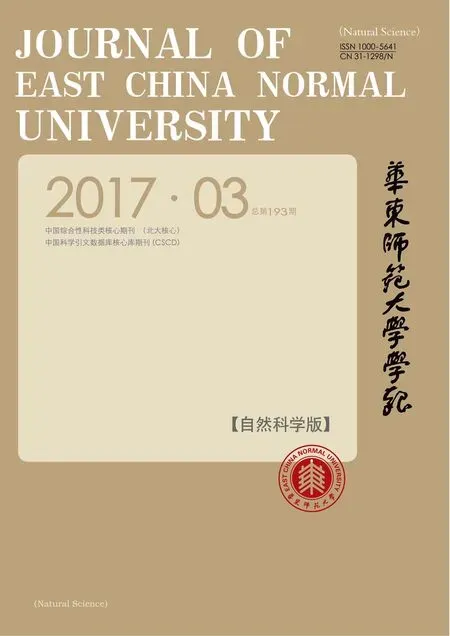Experimental generation of a neat semi-Gaussian laser beam with a coherence attenuator
FANG Bin,YIN Ya-ling,YE Zhang-dong,MAO Zhi-xiang, GUO Chao-xiu,XIA Yong
(State Key Laboratory of Precise Spectroscopy,School of Physics and Materials Science, East China Normal University,Shanghai200062,China)
Experimental generation of a neat semi-Gaussian laser beam with a coherence attenuator
FANG Bin,YIN Ya-ling,YE Zhang-dong,MAO Zhi-xiang, GUO Chao-xiu,XIA Yong
(State Key Laboratory of Precise Spectroscopy,School of Physics and Materials Science, East China Normal University,Shanghai200062,China)
Based on our former theoretical analysis[Yaling Yin,et al,Opt.Commun. 281(22),5511(2008)],we experimentally design a simple optical device to generate a neat semi-Gaussian laser beam(SGB)without dif f raction fringes by using a coherence attenuator and a thin sharp blade.The coherence attenuator is composed of two organic glasses and a piece of plastic film rotated by a motor,which can efficiently decrease the coherence of the laser field.In the experiment,we use He-Ne laser as light source and obtain a 632.8 nm neat SGB without dif f raction fringes with a quality factor QSGB=1:16.42 at the propagating position z=0.5 cm.The experimental results show that the generated SGB’s quality factor decreases with the increasing of the propagating distance.The ascent border width of the generated SGB is independent on the waist radius and wavelength of the incident Gaussian beam,which corresponds well with the theoretical analysis.Our generated SGB can be widely used in modern optics for its asymmetric intensity profile and good propagating properties.
semi-Gaussian laser beam;coherence attenuator;propagating properties
0 Introduction
Since the birth of the laser in 1960,the laser has aroused people’s interest around the world and the laser technique has made a great progress in many fields.Many scientists have focused their attentions on the generation of laser beams with different intensity prof i les as they can be widely used in numerous fields of both researches and applications.So far,not a few researchers have achieved great success in generating laser beams with various intensity prof i les,such as hollow laser beam[1-3],f l at-topped laser beam[4-7],semi-Gaussian laser beam[8-9],Airy laser beam[10]and so on.Among of them,a neat semi-Gaussian laser beam(SGB)with no dif f raction fringes is what we have always been most interested in and devoted to.The SGB has an intensity distribution of a half Gaussian profile in one transverse direction and an entire Gaussian profile in the orthogonal transverse direction.A neat SGB has several unparalleled advantages in applications of modern optics and atomic(molecular)physics.For example,the self-bending of the SGB in the nonlinear refractive material can be used in the nonlinear refractive index measurement of materials and optical data storage[11].Besides,a single SGB can be used to decelerate and cool continuous-wave molecular beam.The theoretical investigations concerning molecular deceleration or ref l ection by the neat SGB in conjunction with the optical dipole force also have been reported[12-15].So up to now,many scientists have succeeded in converting a TEM00Gaussian beam profile into a semi-Gaussian one through various methods[8-9,13,16]. Some of the processes can easily be achieved while others are relatively complex.But the general method to generate a SGB is using a sharp blade to shelter half profile of the TEM00Gaussian laser beam despite the only def i ciency that the beam includes many oscillating dif f raction fringes generated by the straight edge[13,16].In 2008,we proposed a special scheme to generate a neat SGB with no dif f raction fringes by use of the combination of a spatial light modulator and a sharp blade and performed the theoretical study[8].Later on,we experimentally demonstrated another special method,based on the use of a transversely nonuniform quasi-phase-matching (QPM)grating(a transversely varying periodically-poled LiTaO3(TPPLT)crystal)to convert a 1 064 nm Gaussian pump beam to a neat 532nm SGB in 2011[9].This generated SGB will convert into a SGB with dif f raction fringes when propagating in the free space for a short distance of several mm[9,17].Meanwhile,there exist some limitations.The requirements on the device,equipment,experimental condition or operations are very strict.It is depended on the incident laser wavelength and the efficiency of the energy transformation is low.In this paper,based on the theoretical analysis in Ref.[8],we experimentally demonstrate a simpler method to transfer an incident Gaussian laser beam to a neat SGB with the same wavelength and a better propagating property based on the use of a coherence attenuator and a thin sharp blade.
Since the SGB generated with the general method includes many oscillating dif f raction fringes due to the coherence properties of the laser source,it is crucial to attenuate the coherence of the laser beam so as to prevent the dif f raction fringes[8].As a result,we design and fabricate a coherence attenuator to decrease the coherence of the laser beam and then incident it to a sharp blade to obtain a neat SGB without dif f raction fringes.The experimental setup to generate a neat SGB using the coherence attenuator and a thin sharp blade is shown in Fig.1. In our experiments,the initial incident Gaussian laser beam whose waist radius is around a few millimeters propagates along thezdirection and first passes through the collimated system composed of lensL1and lensL2.The distance between the two lenses is the sum of their focal length.These two lenses compose an inverse telescope system which can help compress or expand and collimate the incident Gaussian laser beam.Next we put the coherence attenuator into the light path right behind the lensL2in order to decrease the coherence of the laser beam.As the light after the coherence attenuator is parallel,the distance between the coherence attenuator and the sharp blade has no inf l uence on the generated SGB.Then we make the straight edge of a thin and sharp blade vertically insert into the center of the collimated Gaussian beam after the coherence attenuator.The sharp blade cuts the laser beam inxdirection as shown in Fig.1.Thus the intensity distribution of the Gaussian beam is divided into two halves in thex-yplane,one is sheltered by the straight edge of the blade,the other still exists but the intensity distribution has been af f ected.By now a neat semi-Gaussian laser beam whose cross section has an intensity distribution of a half Gaussian profile inxdirection and a Gaussian profile inydirection has been generated after the blade.For the sake of detection of the generated SGB intensity distribution,we put a CCD(Charge Coupled Device)camera right behind the blade.After the blade,we can obtain a neat SGB with a good asymmetric profile in a certain propagating distance.
As is shown in Fig.1 and Fig.2,the coherence attenuator is just a simple device but plays a key role in the generation of a neat SGB.We process the organic glass(poly methyl meth acryl ate,PMMA)into a thin round shape with a diameter of 11 cm,and similarly process the transparent plastic film with a micro-sized graininess into the same size.Next,we tuck the transparent plastic film between two pieces of organic glass.Then we f i x them on an electromotor together which is powered by a direct-current power supply.So a coherence attenuator has been made.As shown in Fig.2(a),the plastic film has a random grain distribution,which can disturb the phase of the incident Gaussian laser beam.When the organic glass with transparent plastic film is rotated,the coherence of the laser beam is greatly decreased even completely destroyed.The working principle of the coherence attenuator can be interpreted using the theoretical model in Ref.[8].The coherence attenuator disturbs the phase of the collimated laser and adds a random phase into the laser field.According to the theoretical investigation performed by us[8],we assume that the coherence attenuator can be divided inton micro-divisions and each micro-division in the plane of the coherence attenuator has a f i xed phase,but the phases of the adjacent micro-divisions are different and the phases of different micro-divisions are evenly distributed between 0 and 2π.The larger n is,the lower coherent degree of the collimated Gaussian laser light is.Since the coherent degree of the light is very low,the interference between the light waves will certainly be eliminated and the dif f raction fringes of the generated SGB thus disappear entirely.
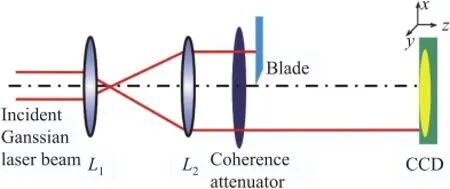
Fig.1The simplified SGB experimental setup that we perform in the experiments
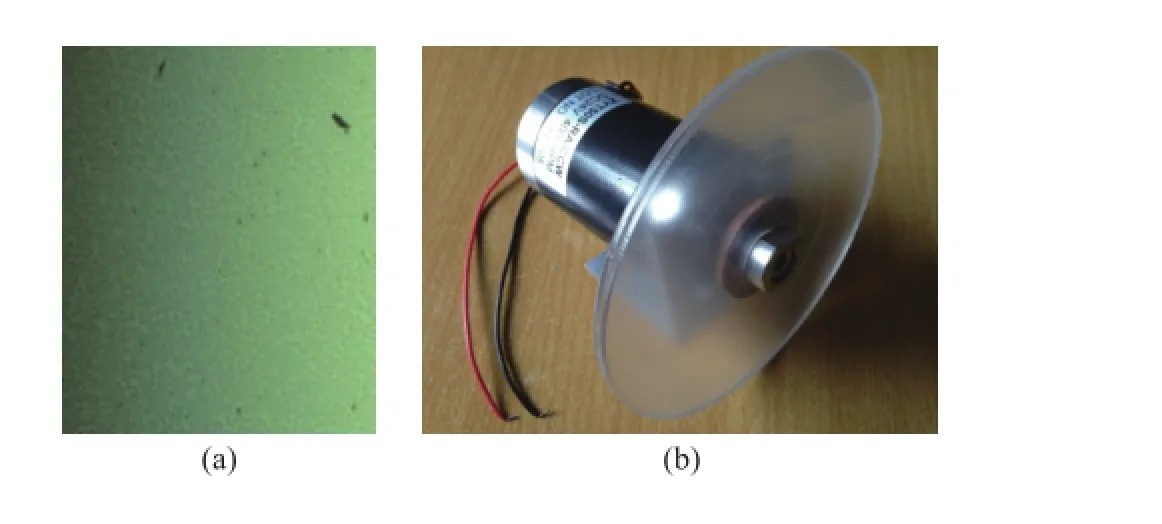
Fig.2 (a)the picture of the transparent plastic film detected by the microscope;(b)the picture of the complete coherence attenuator
As is shown in Fig.1,in the experiment,we use a He-Ne laser as the light source and the laser is incident along thez-axis.The focal length of the lensL1is 10 cm and the focal length of the lensL2is 25 cm.Thus the distance between the lensL1and lensL2is 35 cm (the sum of their focal length).Then we set the voltage supplying for the electro-motor of the coherence attenuator as 20 V.In the experiment,the sharp blade is 10 cm away from the coherence attenuator.We can obtain a neat SGB after the blade.In the experiment,the 1D and 2D light intensity distributions of the generated SGB after the sharp blade are detected by the CCD.
Fig.3 shows the detected light intensity distributions of the Gaussian laser beam and SGB at different positions after the blade.It is evident that the incident Gaussian laser beam has been transformed into a SGB with a steep border width and without dif f raction fringes.Based on the analysis of the detected data,we f i nd that the border widthwB(def i ned as a width at 1/e2of the maximal intensity of the sharp border in the generated SGB)of the generated SGB at the positionz=2 cm shown in Fig.3(d)iswB=0.303 mm.At the same time,the width at 1/e2of the maximal intensity of the semi-Gaussian profile is def i ned as the waist radiuswSGBof the generated SGB and it equals towSGB=4.27 mm.It is clear that the border widthwBis very small compared to the beam waistwSGB,and the corresponding quality factor ofthe generated SGB isQSGB=wB∶wSGB=1∶14.Also,we f i nd that the generated SGB in this scheme has a special character that it can propagate in the free space for a certain distance. Fig.3(e)and(f)shows the SGB light distribution at the propagating positionz=10.5 cm.We can see that the generated neat SGB still has a smaller border width compared to the SGB width,though its asymmetries becomes worse when propagating to the positionz=10.5 cm in the free space.Also,the distribution of the semi-Gaussian part in the SGB has been out of thesemi-Gaussian shape.The quality of the generated SGB at the positionz=10.5 cm isQSGB=wB∶wSGB=1∶6.23.This is different from that of the generated SGB using the TPPLT as a beam shaper.In the TPPLT scheme,the generated SGB propagating in the free space can be transformed into a SGB with dif f raction fringes for a certain distance of only several mm[9,17].
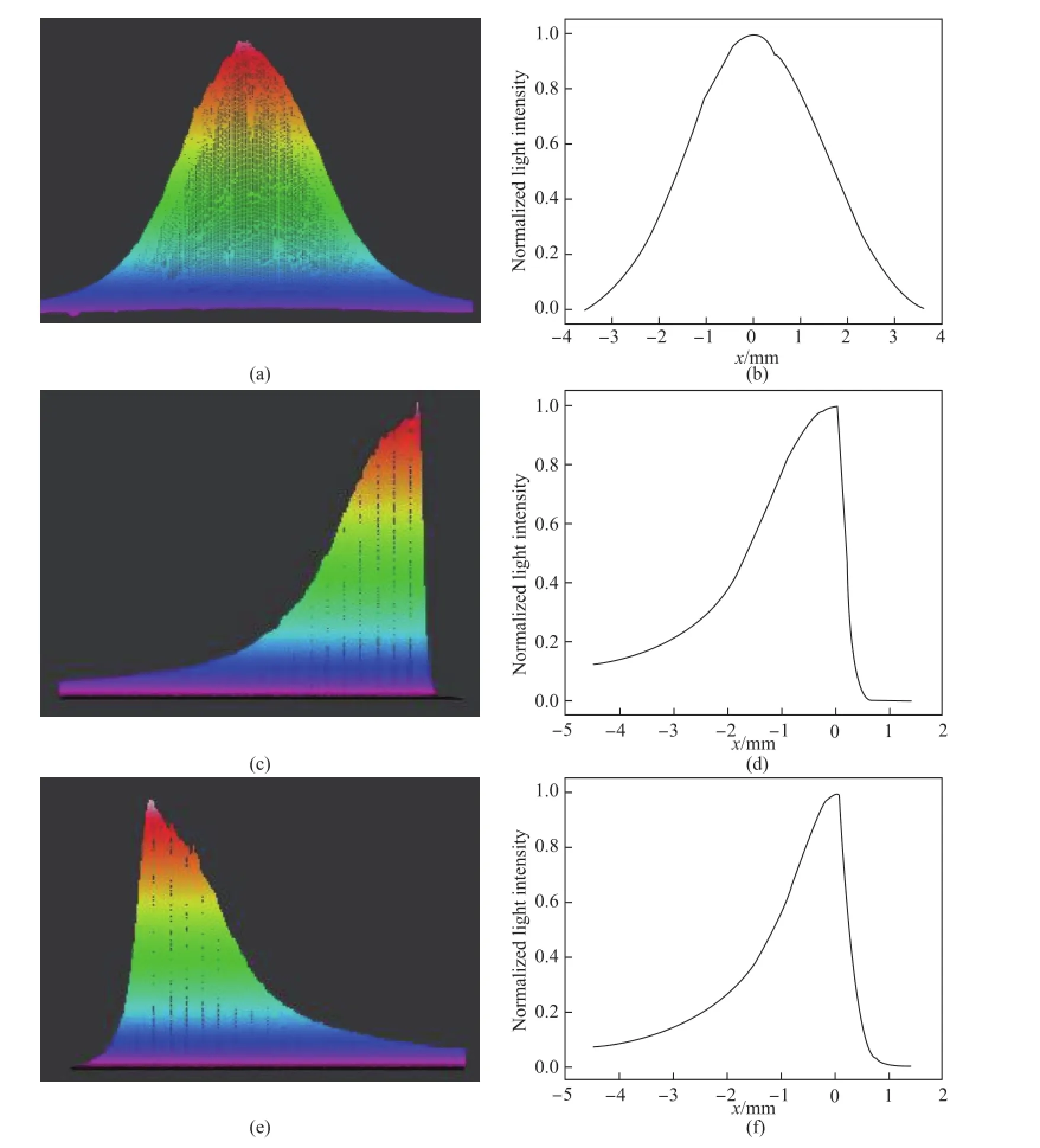
Fig.3 The 2D light intensity distributions of the incident Gaussian laser beam(a),the generated SGB at the propagating position z=2 cm(c)and z=10.5 cm(e);The 1D light intensity prof i les of the incident Gaussian laser beam(b)and the generated SGB at the propagating position z=2 cm (d)and z=10.5 cm(f)along the x-axis
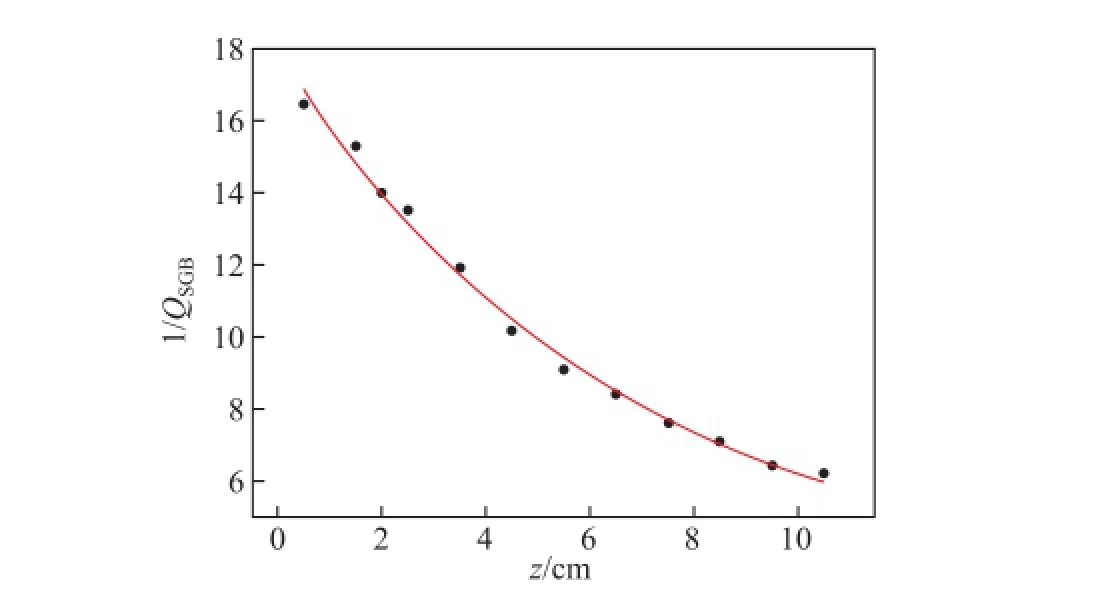
Fig.4 The relationship between 1/QSGBof the generated SGB and the propagating distance z away from the blade
In this experiment,as the asymmetries of the generated SGB becomes worse when propagating in the free space,we are intended to explore the relationship between the quality factorQSGBand the propagating distance away from the blade.We detect the light intensity prof i les inx-yplane vertical to thez-axis in different propagating positions by moving the CCD camera along the propagation direction behind the blade.Finally we draw a graph based on the calculations.The experimental results are shown in Fig.4.As we can see,the 1/QSGBof the generated neat SGB in the plane near the edge of the blade is the largest,but decreases as the distance away from the blade is increasing.At the positionz=0.5 cm,the quality factor of the generated SGB isQSGB=1∶16.45.When it propagates to the positionz=4.5 cm,the quality factor of the generated SGB is increased toQSGB=1∶10.19.When it propagates to the positionz=10.5 cm,the quality of the generated SGB is increased toQSGB=1∶6.23. According to the above data,with the increasing of the propagation distance,the ascent border width will be broad obviously and it is not sharp any more.What is to say,the quality of SGB becomes worse.So here we def i ne the distance where 1/QSGB>10 as an ef f ective propagation distance of the neat SGB and it is about 4.5 cm in our experiment,which is ten times that of the generated SGB in the TPPLT scheme[9,17].Beyond this distance,the neat SGB will transfer into a worse SGB.That is to say,the generated SGB in this experiment can keep a good asymmetric character for a certain distance,which is benef i t for the applications of the neat SGB.
Based on the theoretical analysis of the SGB generation in Ref.[8],we f i nd that the border width of the generated SGB is not related to the waist radius of the incident Gaussian laser beam.In this experiment,we have studied the dependence of the ascent border width of the generated SGB on the waist radius of the incident Gaussian beam and compare it with the theoretical analysis.To get Gaussian beams with different waist radius,we need to change the ratios of the focal length of lensL1and lensL2so as to get several different ratios of their focallength,and then obtain different Gaussian laser beams with different waist radius.In addition, the other parameters of the optical system keep the same.Later we detect the light intensity distributions after the blade.The experimental results show that the ascent border width of the generated SGB keeps nearly the same value as the waist of the incident beam increases. All the experimental results indicate that the ascend border width of the generated neat SGB in the same position is almost not related to the waist of the incident Gaussian beam,which is consistent with the theoretical results.
In conclusion,we have experimentally designed a new and simple method to generate a neat SGB,which is not related to the wavelength of the laser light.We have designed and fabricated a coherence attenuator to decrease the coherence of the laser field.We use He-Ne laser as our light source and obtain a 632.8 nm neat SGB without dif f raction fringes with a quality factor QSGB=1∶16.42 at the propagating position z=0.5 cm.The propagation properties of the generated SGB as well as the dependence of the ascent border width of the SGB on the waist radius of the Gaussian beam have also been studied.We f i nd that the generated neat SGB can propagate in the free space for a certain distance of~4.5 cm while keeping a good asymmetric distribution,which is ten times that of the generated SGB in the TPPLT scheme. Even though the generated SGB will be transformed into a worse asymmetric distribution when the propagating distance is larger than 4.5 cm,there are still no dif f raction fringes in the SGB. What’s more,the border width of the generated SGB is independent on the waist radius of the incident Gaussian laser beam.The experimental results indicate that what we do is an ef f ective and a practical method to generate a high-quality neat semi-Gaussian laser beam.As a rotated ground glass can decrease the coherence of the laser field,it can also work a coherence attenuator in our scheme.Our method to generate a neat SGB by using a coherence attenuator is not only simple but also convenient and cheap in cost.For further development,the neat SGB we obtain can make many contributions in many fields.
[1]YIN J P,GAO W J,ZHU Y F.Generation of dark hollow beams and their applications[J].Prog Opt,2003,45: 119-204.
[2]SCHWEIGER G,NETT R,OZEL B,et al.Generation of hollow beams by spiral rays in multimode light guides [J].Opt Express,2010,18(5):4510-4517.
[3]GRANATA M,BUY C,WARD R,et al.Higher-order Laguerre-Gauss mode generation and interferometry for gravitational wave detectors[J].Phys Rev Lett,2010,105(23):2555-2558.
[4]B´eLANGER P A,LACHANCE R L,PAR´e C.Super-Gaussian output from a CO2laser by using a graded-phase mirror resonator[J].Opt Lett,1992,17(10):739-741.
[5]KASINSKI J J,BURNHAM R L.Near-dif f raction-limited laser beam shaping with diamond-turned aspheric optics[J].Opt Lett,1997,22(14):1062-1064.
[6]LIU J S,TAGHIZADEH M R.Iterative algorithm for the design of dif f ractive phase elements for laser beam shaping[J].Opt Lett,2002,27(16):1463-1465.
[7]IMESHEV G,PROCTOR M,FEJER M M.Lateral patterning of nonlinear frequency conversion with transversely varying quasi-phase-matching gratings[J].Opt Lett,1998,23(9):673-675.
[8]YIN Y L,XIA Y,YIN J P.A neat semi-Gaussian laser beam with no dif f raction fringes:Theoretical analysis [J].Opt Commun,2008,281(22):5511-5514.
[9]YIN Y L,LYU X J,ZHAO L N,et al.Nonlinear generation of a neat semi-Gaussian laser beam with a transversely varying periodically-poled LiTaO3crystal[J].Opt Express,2011,19(6):5297-5302.
[10]ELLENBOGEN T,VOLOCH-BLOCH N,GANANY-PADOWICZ A,et al.Nonlinear generation and manipulation of Airy beams[J].Nat Photonics,2009,3(7):395-398.
[11]DING Y J,GUO C L,SWARTZLANDER G A,et al.Spectral measurement of the nonlinear refractive index in ZnSe using self-bending of a pulsed laser beam[J].Opt Lett,1990,15(24):1431-1433.
[12]YIN Y L,XIA Y,YIN J P.Deceleration of a continuous-wave(CW)molecular beam with a single quasi-CW semi-Gaussian laser beam[J].Chin Phys B,2008,17(10):3672-3676.
[13]ZHENG P,GAO W J,YIN J P.Novel atomic mirror with a blue-detuned semi-Gaussian beam[J].Chin Phys Lett,2003,20(3):379-382.
[14]XIE C X,WANG Z L,YIN J P.A Novel Gravito-Optical Surface Trap for Neutral Atoms[J].Chin Phys Lett, 2006,23(4):822-825.
[15]YIN Y L,ZHOU Q,XIA Y,et al.A novel mirror for cold molecules with a semi-Gaussian beam[J].Chin Phys Lett,2008,25(9):3215-3218.
[16]LI J C,MERLIN J,PEREZ J.Etude comparative de dif f´erents dispositifs permettant de transformer un faisceau laser de puissance avec une r´epartition´energ´etique gaussienne en une r´epartition uniforme[J].Rev Phys Appl, 1986,21:425-433.
[17]GUO C X,LING C,DU X L,et al.Theoretical study on propagation properties of semi-Gaussian laser beam [J].Laser&Optoelectronics Progress,2013,50:121405-121431.
[18]BORN M,WOLF E.Principles of Optics[M].Cambridge:Cambridge University Press,1980.
(责任编辑:李艺)
基于相干衰减器的半高斯激光束的产生实验研究
方彬,尹亚玲,叶张东,茅志翔,郭超修,夏勇
(华东师范大学物理与材料科学学院精密光谱科学与技术国家重点实验室,上海200062)
根据之前的理论分析(Yaling Yin,et al,Opt.Commun.281(22),5511(2008)),实验上设计了一个由相干衰减器和锋利薄刀片构成的产生无衍射条纹的纯净半高斯激光束的简单光学装置.装置中相干衰减器由两片有机玻璃片和一片塑料薄膜构成,并由马达驱动,该相干衰减器可以有效降低激光场的相干度.实验中,选择氦-氖激光作为实验光源,在传输位置z=0.5 cm处获得了品质因子QSGB=1∶16.42的无衍射条纹的纯净半高斯激光束.实验结果显示,产生的半高斯激光束的品质因子随着传输距离的增加而减少,产生的半高斯激光束的陡峭上升沿的宽度与入射高斯光束的波长和束腰半径无关,这与之前的理论计算结果一致.实验上产生的半高斯激光束因为具有非对称性的强度分布、优良的空间传输特性,所以在现代光学中有广泛的应用.
半高斯激光束;相干衰减器;传输特性
2016-04-16
国家自然科学基金(11274114);华东师范大学大夏基金(2014DX-055)
方彬,男,本科生,研究方向为激光光学.E-mail:fangbin1752@163.com.
尹亚玲,女,副教授,研究方向为激光光学、材料光学、原子分子与量子光学. E-mail:ylyin@phy.ecnu.edu.cn.
O431
A
10.3969/j.issn.1000-5641.2017.03.009
1000-5641(2017)03-0087-07

